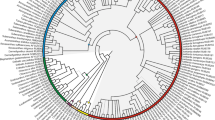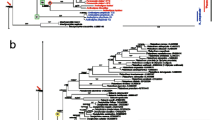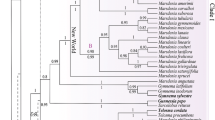Summary
Morphological studies based on the protologues, observations of herbarium specimens and field surveys suggest that Goodyera rosulacea is a synonym of G. brachystegia. According to genetic studies, accessions of G. rosulacea and G. brachystegia form a single clade in the phylogenetic trees obtained from analyses of the nuclear ribosomal DNA ITS region and four plastid regions (accD-psaI, matK, trnK-rps16 and trnL-F). This phylogenetic evidence further underpins the conclusion that the two names refer to one and the same species.


Similar content being viewed by others
References
Burland, T. G. (2000). DNASTAR’s Lasergene sequence analysis software. In: S. Misener & S. A. Krawetz (eds), Methods in Molecular Biology 132: 71 – 91. Springer, Berlin.
Chen, S. C., Lang, K. Y., Gale, S. W., Cribb, P. J. & Ormerod, P. (2009). Goodyera. In: Z. Y. Wu, P. H. Raven & D. Y. Hong (eds), Flora of China 25: 45 – 54. Science Press, Beijing, China & Missouri Botanical Garden Press, St. Louis, Missouri.
Doyle, J. J. & Doyle, J. L. (1987). A rapid DNA isolation procedure for small quantities of fresh leaf tissue. Phytochem Bull. Bot. Soc. Amer. 19: 11 – 15.
Fay, M. F., Bone, R., Cook, P., Kahandawala, I., Greensmith, J., Harris, S., Pedersen, H. E., Ingrouille, M. J. & Lexer, C. (2009). Genetic diversity in Cypripedium calceolus (Orchidaceae) with a focus on north-western Europe, as revealed by plastid DNA length polymorphisms. Ann. Bot. 104(3): 517 – 525.
Govaerts, R., Bernet, P., Kratochvil, K., Gerlach, G., Carr, G., Alrich, P., Pridgeon, A. M., Pfahl, J., Campacci, M. A., Holland Baptista, D., Tigges, H., Shaw, J., Cribb, P. J., George, A., Kreuz, K. & Wood, J. J. (2019). World Checklist of Orchidaceae. http://wcsp.science.kew.org/namedetail.do?name_id=91754.
Gravendeel, B., Chase, M. W., De Vogel, E. F., Roos, M. C., Mes, T. H. M. & Bachmann, K. (2001). Molecular phylogeny of Coelogyne (Epidendroideae; Orchidaceae) based on plastid RFLPS, matK, and nuclear ribosomal ITS sequences: evidence for polyphyly. Amer. J. Bot. 88(10): 1915 – 1927.
Handel-Mazzetti, H. R. E. (1936). Goodyera brachystegia. In: Symbolae sinicae 7 (5): 1345. Verlag von Julius Springer, Wien.
Hu, C. (2013). Molecular phylogeny of Goodyera (Orchidaceae) in China. Master's thesis, East China Normal University, Shanghai, China. pp. 30 – 44. [In Chinese]
Hu, C., Tian, H. Z., Li, H. Q., Hu, A. Q., Xing, F. W., Bhattacharjee, A., Hsu, T., Kumar, P. & Chung, S. W. (2016). Phylogenetic analysis of a ‘jewel orchid’ genus Goodyera (Orchidaceae) based on DNA sequence data from nuclear and plastid regions. Plos One 11(2): e0150366.
Hu, S. Y. (1973). The Orchidaceae of China (VI). Quart. J. Taiwan Mus. 26 (3 – 4): 399.
Johnson, L. A. & Soltis, D. E. (1994). MatK DNA sequences and phylogenetic reconstruction in Saxifragranceae s. str. Syst. Bot. 19: 143 – 156.
Kocyan, A., Qiu, Y. L., Endress, P. K. & Conti, E. (2004). Phylogenetic analysis of Apostasioideae (Orchidaceae) based on ITS, trnL-F and matK sequences. Plant Syst. Evol. 247: 203 – 213.
Lang, K. Y. & Tsi, Z. H. (1978). Some new taxa of Orchidaceae from Tibet, China. Acta Phytotax. Sin. 16 (4): 126–129.
Lee, Y. N. (2004). New taxa of Korean flora. Bull. Korea Pl. Res. 4: 2. [In Korean with English summary]
Liu, Y. W., Zhou, X. X., Schuiteman, A., Kumar, P., Hermans, J., Chung, S. W. & Tian, H. Z. (2019). Taxonomic notes on Goodyera (Goodyerinae, Cranichideae, Orchidoideae, Orchidaceae) in China and an addition to orchid flora of Vietnam. Phytotaxa 395(1): 27 – 34.
Molvray, M., Kores, P. J. & Chase, M. W. (2000). Polyphyly of mycoheterotrophic orchids and functional influences on floral and molecular characters. In: K. L. Wilson & D. A. Morrison (eds), Monocots: Systematic and Evolution, pp. 441 – 448. CSIRO, Melbourne, Victoria.
Nylander, J. A. A. (2004). MrModeltest v2. Program distributed by the author, Evolutionary Biology Centre, Uppsala University, Uppsala. https://github.com/nylander/MrModeltest2.
Pridgeon, A. M., Cribb, P. J., Chase, M. W. & Rasmussen, F. R. (2003). Genera Orchidacearum. Vol. 3. Orchidoideae (part 2). Vanilloideae. Oxford University Press. Oxford.
Ronquist, F, Huelsenbeck, J. P. & Van der Mark, P. (2005). MrBayes 3.1 Manual. http://mrbayes.csit.fsu.edu/manual.php.
Schlechter, R. (1912). Die Orchidaceae Von Deutsch-Neu-Guinea. Repert. Spec. Nov. Regni Veg. Beih. 1: 47 – 53.
Shaw, J., Lickey, E. B., Schilling, E. E. & Small, R. L. (2007). Comparison of whole chloroplast genome sequences to choose noncoding regions for phylogenetic studies in Angiosperms: the tortoise and the hare III. Amer. J. Bot. 94: 275 – 288.
Stamatakis, A. (2014). RAxML version 8: a tool for phylogenetic analysis and post-analysis of large phylogenies. Bioinformatics. 30(9): 1312 – 1313.
Swofford, D. L. (2002). PAUP*: Phylogenetic Analysis Using Parsimony (*and Other Methods). Version 4.0b10. Sinauer Associates, Sunderland, Massachusetts.
Taberlet, P., Gielly, L., Pautou, G. & Bouvet, J. (1991). Universal primers for amplification of three non-coding regions of chloroplast DNA. Pl. Molec. Biol. 17: 1105 – 1110.
Tamura, K., Peterson, D., Peterson, N., Stecher, G., Nei, M. & Kumar, S. (2011). Mega5: molecular evolutionary genetics analysis using maximum likelihood, evolutionary distance, and maximum parsimony methods. Molec. Biol. Evol. 28(10): 2731 – 2739.
Venora, G., Blangiforti, S., Frediani, M., Gelati, M. T., Castiglione, M. R. & Cremonini, R. (2000). Nuclear DNA contents, rDNAs, chromatin organization, and karyotype evolution in Vicia sect. faba. Protoplasma. 213: 118 – 125.
White, T. J., Bruns, T., Lee, S. & Taylor, J. (1990). Amplification and direct sequencing of fungal ribosomal RNA genes for phylogenetics. In: M. A. Innis, D. H. Gelfand, J. J. Sninsky & T. J. White (eds), PCR protocols: A Guide to Methods and Applications, pp. 315 – 322. Academic Press, New York.
Acknowledgements
We are grateful to the National Natural Science Foundation of China (30900077) and for the China Scholarship Council (CSC) scholarship awarded to Huai Zhen Tian.
Author information
Authors and Affiliations
Corresponding author
Additional information
Publisher’s Note
Springer Nature remains neutral with regard to jurisdictional claims in published maps and institutional affiliations.
Rights and permissions
About this article
Cite this article
Zhou, S., Zhou, X.X., Jin, Y. et al. On the identity of Goodyera rosulacea (Orchidaceae: Orchidoideae: Cranichideae: Goodyerinae). Kew Bull 75, 3 (2020). https://doi.org/10.1007/s12225-019-9855-9
Accepted:
Published:
DOI: https://doi.org/10.1007/s12225-019-9855-9




